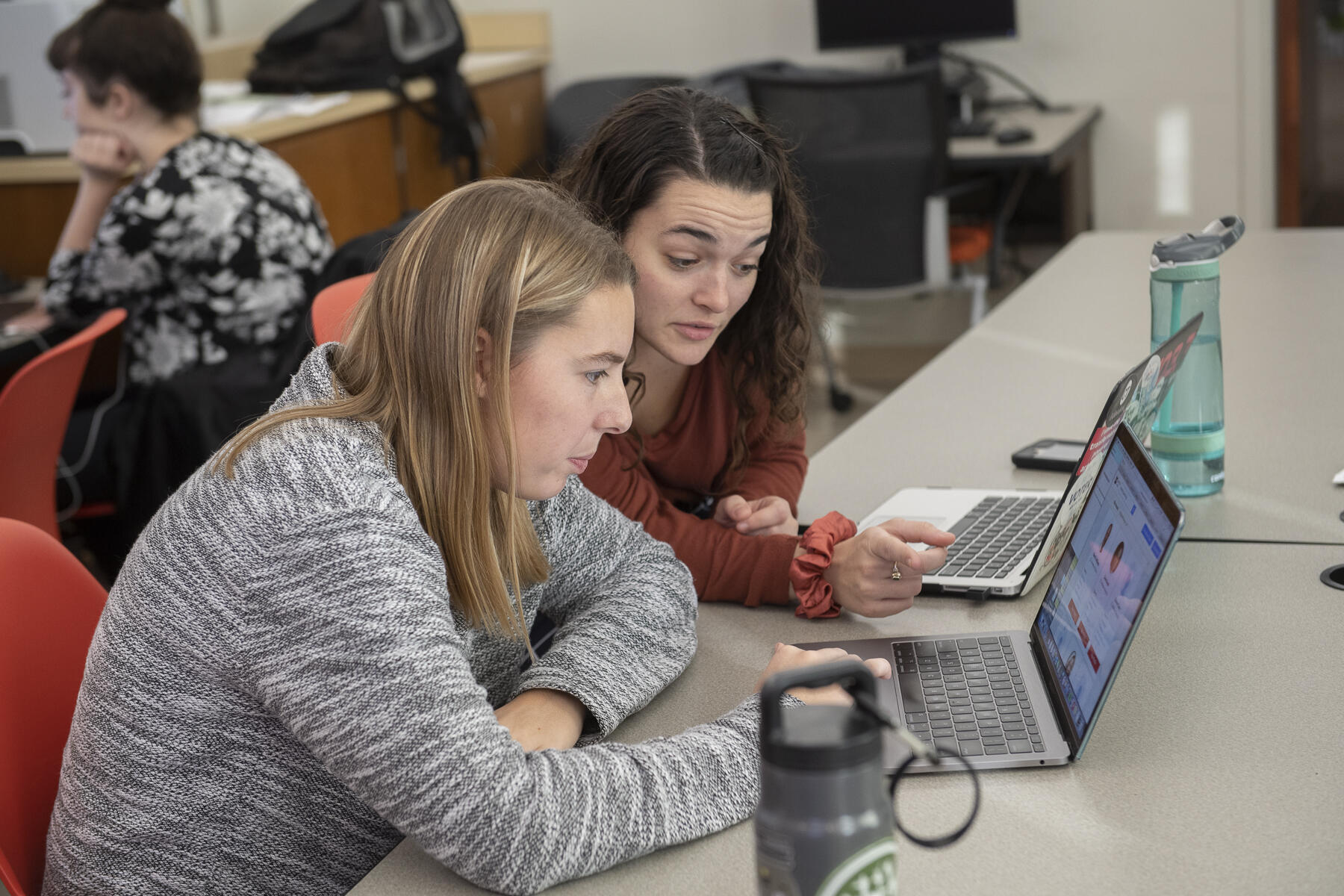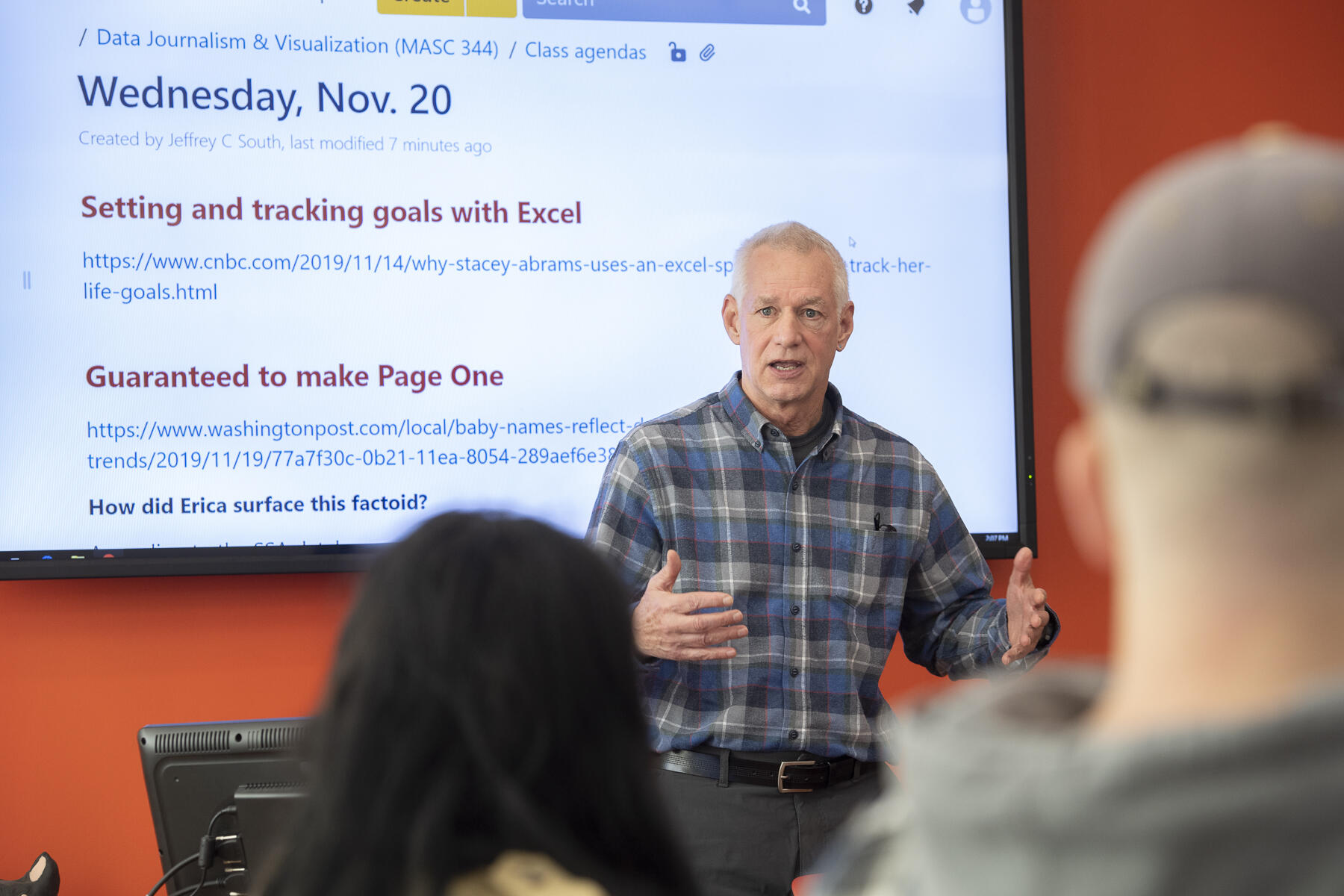
Dec. 9, 2019
Taking a big data approach, these VCU students are getting published by hundreds of news outlets
Students in a data journalism class are producing stories being picked up by The Washington Post, The Associated Press and other publications across the country.
Share this story
As an assignment for her Data Journalism and Visualization class, Virginia Commonwealth University student Erica Mokun analyzed a Social Security Administration database of thousands of baby names in Virginia going back to 1910. She wrote an article revealing trends such as the growing popularity of names like Ava and Liam, along with the rise of names like Mateo that reflect a growing Spanish-speaking population.
Mokun’s article was distributed by VCU Capital News Service — which provides news stories written by VCU journalism students to The Associated Press and more than 100 news outlets across Virginia — and was picked up by CBS 6 in Richmond, NBC 4 in Washington and The Washington Post, among many others.
“Oh my gosh. My mom started crying. She never imagined this little girl from Massachusetts would be published in The Washington Post,” said Mokun, who grew up in Boston and is a senior broadcast journalism major in the Richard T. Robertson School of Media and Culture in the College of Humanities and Sciences.
Mokun’s article is one of dozens to emerge this fall from the new Data Journalism and Visualization class taught by Jeff South, an associate professor of journalism at the Robertson School and director of the Capital News Service.
The course trains students in computer-assisted reporting and data-driven storytelling, with a focus on tracking down authoritative sources and information on the internet, analyzing data with spreadsheets and other tools, and creating online graphics.
“This is an area of journalism that is really important for finding employment with news organizations nowadays,” South said. “It’s the ability to tell exclusive stories. You’re not beholden to covering a press conference or an official statement by somebody. Instead, you’re coming up with original reported information that isn’t otherwise available.”

Students Sravan Gannavarapu and Hannah Eason wrote another story that received widespread attention: They used an online tool to scrape 3,000 comments on news stories about Ghazala Hashmi, Ph.D., becoming the first Muslim American elected to serve in the Virginia Senate. They analyzed the data and found a high volume of racist comments on articles by Richmond-area news outlets.
More than 800 media organizations published their story. “It's been around the world. Middle East, Africa, the U.K., and all across the United States — from The Washington Post to the [Los Angeles] Times. Everybody ran it,” South said.
Gannavarapu suggested the story on the comments about Hashmi while he was working at CBS 6 on election night and covering the Senate race as part of another VCU journalism class.
“One of the anchors pulled up the Facebook page and we saw a lot of racist comments,” he said. “[Hashmi] is actually from the same area that my family is from in India. So I thought, ‘We should do a story on the comments people are making about her.’”
Eason, meanwhile, was working throughout the night leading election coverage as news editor for The Commonwealth Times. “After running [the CT’s coverage], I came to this class the next day — we’d had production until like 6 in the morning — and I had seen the comments when I woke up, and Sravan had the idea to do the story. I thought it was a great idea and I was like, I’d love to help with that.”
A third student, senior public relations major Catalina Currier, found a tool online that allowed them to vacuum up all of the comments on the news stories about Hashmi, and then South helped them conduct an analysis of the database they built.
“It was a real team effort,” he said.
This is an area of journalism that is really important for finding employment with news organizations nowadays. It’s the ability to tell exclusive stories.
Along with data analysis, the students are learning ways to illustrate news stories with graphics and other visual storytelling devices.
For example, during a recent class, South showed the students how to use a free online tool called Story Maps that allows a journalist to display points on a map. He showed past projects by students that mapped out places to go salsa dancing in Richmond, the locations of historic African American cemeteries that received state support for maintenance, and the countries of origin for each film in a Richmond international film festival.
South also demonstrated how to use a tool called TimelineJS that allows a user to make a timeline that illustrates a news story.
“A lot of students have graduated from our program and gone on to work in newsrooms where [other journalists] are not really familiar with this,” he said. “They've been able to do some real razzle-dazzle and say, ‘Hey, why don't we do a timeline for this story?’”
Last week, data journalism student Pedro Coronado created a timeline and an interactive map to illustrate a long-form article by classmate Georgia Geen about a Chesapeake resident who said he spotted John Allen Muhammad and Lee Boyd Malvo amid the D.C. sniper killings in 2002. Geen’s feature story was picked up by The Washington Post, Richmond-area TV stations and several others.

As the semester winds down, the students have been working in pairs on their final data-driven stories.
One pair of students is looking at the opioid epidemic, using a dataset that will allow them to show how many pills per person have flowed into localities in the Richmond region.
Another is looking at pedestrian deaths across the state, using a database of 880,000 accidents and then drilling down to find the specific intersections where pedestrians were killed.
Emma Gauthier, a senior digital journalism major, and Anna Madigan, a senior broadcast journalism major, are working with a database of every parole decision in Virginia from 2014-19. The database includes roughly 75,000 rows of data showing the outcome each time a Virginia prisoner goes before the state’s parole board to request consideration for parole.
“We’ve found that over 80%, almost 90%, of requests are just denied,” Gauthier said.
In addition to the overall rates of parole requests that are granted or denied, the students also will look at how the rate has changed over time, the difference in who is granted parole based on age and race, and the reasons given for why parole was rejected.
“Before this class, I hadn’t really done any work in Excel before,” Madigan said. “I wanted to take the class because it sounded interesting and I thought I could build my skills.”
The course is the undergraduate version of a graduate class that South also is teaching this fall — MASC 644 Computer-Assisted Reporting. The graduate students also have had success getting their work published.
For instance, Jaclyn Barton, who is enrolled in the multimedia journalism master’s program, did a story analyzing U.S. Postal Service data that found less than 84% of the Richmond region’s first-class mail was delivered on time. The story was picked up by The Associated Press and ran on the websites of The Washington Post, the New York Daily News, The Kansas City Star and about 100 other publications across the country.
Subscribe to VCU News
Subscribe to VCU News at newsletter.vcu.edu and receive a selection of stories, videos, photos, news clips and event listings in your inbox.









